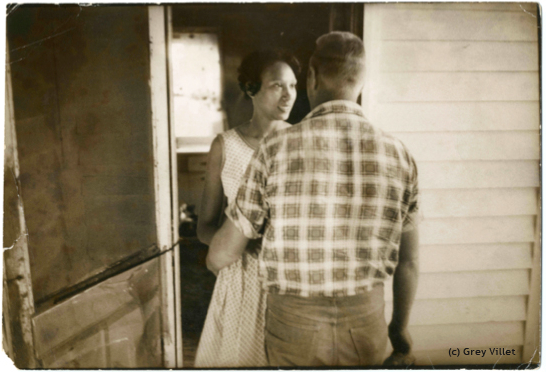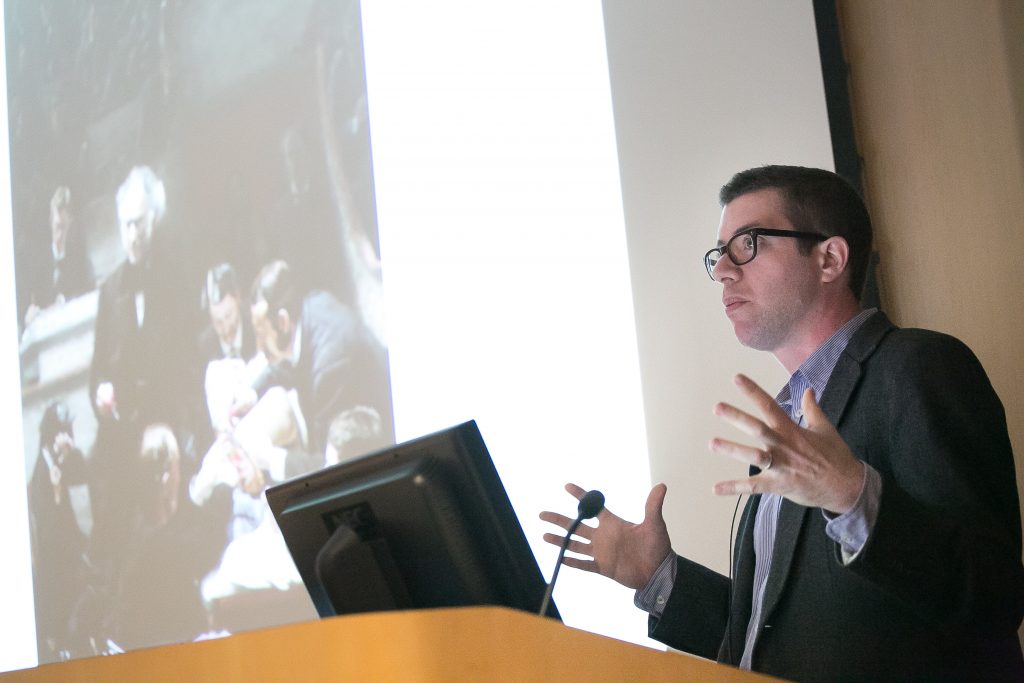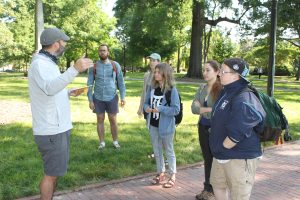
UNC senior Robert Williams is a passionate walker and biker, but he had never considered walking a mode of artistic expression before signing up for the Maymester course “Arts 290: The Walking Seminar.”
Maymester is an experiential summer school mini-term where students can earn three credit hours in three weeks.
Associate Professor of Art Mario Marzan designed the class to reflect contemporary artists who are inspired by walking as an art form. He wanted to get students out of the classroom to experience a “territorial investigation of the North Carolina landscape” and to incorporate the University’s academic theme, “Water in our World.”
Over 13 days, students completed assignments such as contour mapping, flora illustrations, psychological landscape drawings and a large-scale group installation. They used watercolors, graphite pencils, camera phones and more as artistic tools. They read works about walking and art by writers including Henry David Thoreau and Charles Baudelaire.
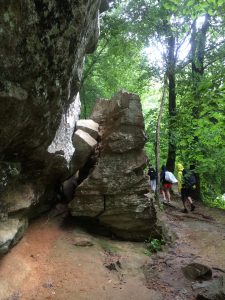
They camped and hiked together in the pouring rain, explored Jordan Lake, the Eno River and Raven Rock State Park, blogged about their experiences and forged an almost instant bond for critical discussion.
“I wanted to create a class that was more real than just sitting and painting in a studio,” said Marzan, an avid hiker and backpacker whose work explores geographical spaces between individual and cultural identity. “But rather than sitting and painting the landscapes en plein air [French for ‘in the open air’], I wanted students to move through the landscape and respond to the aesthetics of the path by making art about their experiences.”
The Walking Seminar course was biology major Williams’ last class as a senior; he plans to graduate in August.
“I really wanted to do something I had never done before,” he said.
Artistic exploration via a campus walk
On a cool Carolina morning, students sat on a bench underneath the Davie Poplar tree awaiting instructions for the day’s assignment. They would complete a Walkabout of the UNC campus, walking in a straight line and counting their steps along the way.
Each student wrote a separate code on a piece of paper which Marzan deciphered. The code unlocked the length of each walk — which ranged from 30 minutes to over an hour — and how often they would stop and switch direction, determined by a flip of a coin. At each stop, they took pictures of and collected objects from their surroundings.
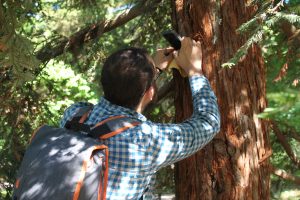
After completing the exercise, students mapped their collective journeys on a blank wall in a Hanes Art Center studio classroom, using string and markers and incorporating photos and found objects into a collaborative drawing. They taped twigs, cigarette butts, a blue kazoo, a bottle cap, a piece of glass, a dead snake and rocks to the wall.
They also worked together to negotiate accurate geographical distances for their life-size map.
“In this assignment, I wanted you to experience campus in a new way,” Marzan told the class. “There’s a sense of adventure that happens. Now we’re putting this up on a big canvas, creating a large-scale installation. Step back and see the kind of shape that your walking journey made; experience it in a two-dimensional form.”
Sarah Hey, a senior studio art and psychology major, began walking northeast from the Davie Poplar. After about 20 minutes, she reached Bolinwood Drive, took a right turn and headed toward Bolin Creek.
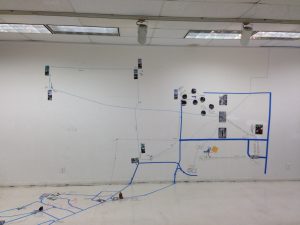
“I really enjoyed the Walkabout, which was interesting and meditative,” she said. “The forest was very dense, and I walked in and out of the creek. I was excited about the things I saw, like little footprints and interesting shapes.”
Camping, cleanup and contour mapping at Jordan Lake
After hearing a presentation on the history of Jordan Lake, the Maymester students hiked down the steps to the dam and saw the rushing water of the Haw River on the other side of the lake. Francis Ferrell of the U.S. Army Corps of Engineers talked about cleanup efforts by the nonprofit Clean Jordan Lake.
Over a two-day period, students picked up trash along the shoreline, walked on the Educational State Forest Talking Tree Trail and camped at New Hope Overlook, a pristine, primitive campsite overlooking the lake.
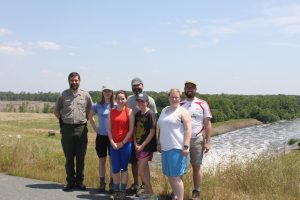
At the New Hope campsite, students sat at a picnic table, surrounded by tents and hammocks, as they discussed dinner: macaroni and cheese, sausages, mixed vegetables, crescent rolls and s’mores.
Marzan picked up a stick and traced a 20-by-20 foot square in the dirt as he explained their next assignment: create a contour map of their own micro-landscapes, capturing trees and logs and sticks and rocks within its borders.
“I want you to do an actual realistic rendering of the landscape in your square but with a bird’s-eye view,” he said. “Examine it from all sides. What kind of composition does it make from above?”
Lea Wright, a senior studio art major, said she liked the assignment.
“It allowed me the time to understand the interior of landscape,” Wright said. “I always feel like I am very observant, but I don’t take into consideration the height and placement of certain things.”
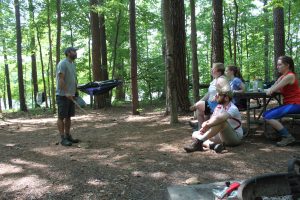
Presenting final projects
On the last day of class, students reminisced about their experiences as they presented final class projects.
Hey was inspired by volunteering for Clean Jordan Lake and by philosopher Slavoj Zizek’s discourse on ecological problems. While vacationing at the Outer Banks over Memorial Day weekend, she created a stop-motion animated video, “Cycle of Trash.”
Hey wrote in her class blog post that she wanted to express “the insidious nature in which trash builds up despite our best efforts.”
For his final project, Williams used the mobile video application Vine to create 360-degree postcards of the Old Well and a walk from Franklin Street to the Pit.
“I really wanted to do something that documented my time here,” Williams said. “I’ve done the walk from Franklin Street to the Pit several hundreds of times.”
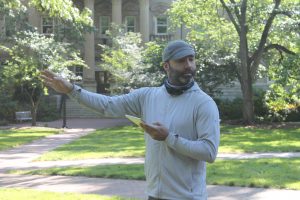
Read more about the students’ final projects.
Marzan said he created The Walking Seminar class based in part on a favorite childhood movie, “Stand By Me.” In the 1986 film, four 12-year-old friends set off on an epic journey to find the body of a local boy who has been missing for several days.
Just a few days after Maymester ended, Marzan set off on his own epic walk — a 34-day pilgrimage across Spain, the El Camino de Santiago, also known as the Way of St. James.
Marzan said he enjoyed watching students’ shift from skepticism about walking as an art form to embracing the idea in just three weeks.
“I wanted them to look at art more critically and to think through other problems outside of art that they might encounter — and to walk, rather than drive,” he added, laughing.
By Kim Weaver Spurr ‘88


